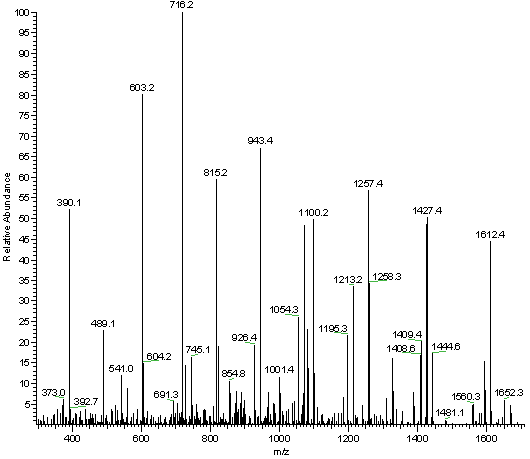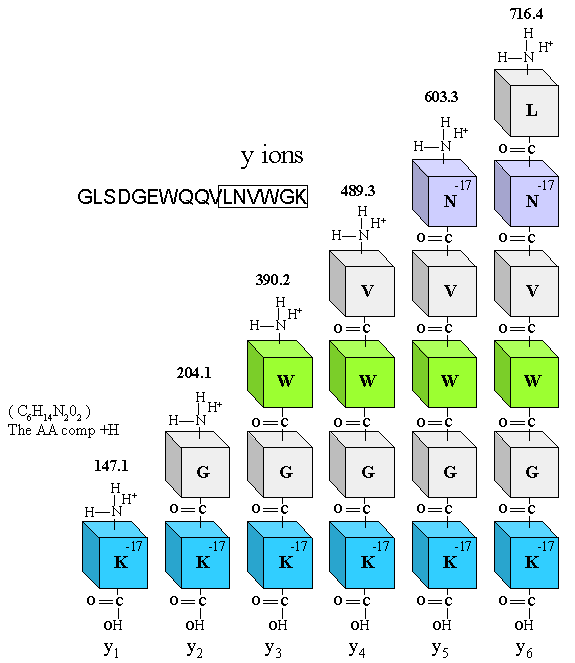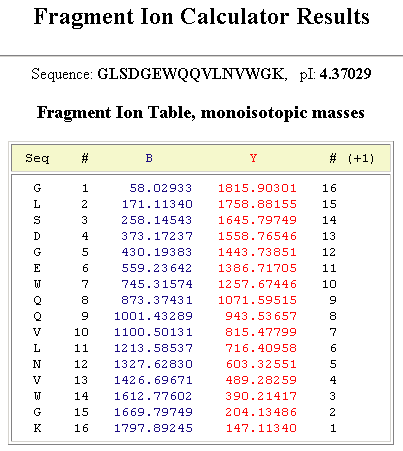|
Advertisement
|
||
|
|
||
| - | ||
|
- De Novo Peptide Sequencing Tutorial More on b and y ions |
||
|
|
||
|
Peptides do not fragment sequentially, that is to say, the first fragmentation event does not start at the amino terminus and proceed sequentially one residue at a time down the amino acid chain. The fragmentation events are somewhat random and definitely not sequential. In addition, some fragmentations are preferred over others as noted by the variation in the abundance of observed peaks in the spectrum below. Most of us can recognize a peptide fragment spectrum just by glancing at it. The peaks will appear to differ by the approximate mass of an amino acid residue as shown below.
|
||
| Figure 1. This is an MS/MS spectrum of the tryptic peptide GLSDGEWQQVLNVWGK. This data was collected on an ion trap mass spectrometer. This spectrum will be the subject of our first unblinded de novo sequencing example. | ||
The mess of peaks normally observed in a fragment spectrum are a reflection of the population of fragment ions produced in the collision cell of a mass spectrometer. The sequence of the peptide is determined by the mass difference between these peaks. To complicate matters there will be y and b ions intermixed that may allow you to to establish a sequence, both forward and backward. Those fragment peaks that appear to extend from the amino terminus are termed "b ions". Figure 2. below demonstrates the ladder or family of "b ions" that may be observed in the fragment mass spectrum for this tryptic peptide. The b fragment peaks are labeled from the amino to the carboxyl terminus. The fragment containing only the amino terminal amino acid is termed b1. The fragment containing the first two amino terminal amino acids is termed the b2 ion, and so forth. The nomenclature is very simple to follow.
Figure 2.
|
||
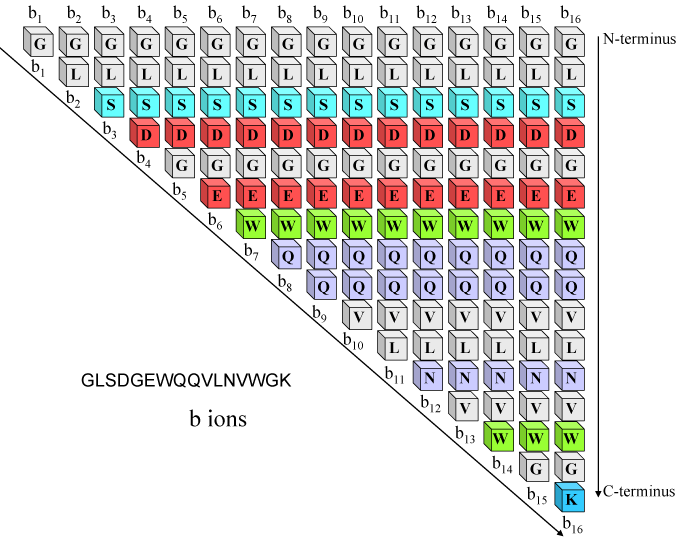
|
||
| Below is a closer look at the generic structure of the first six amino terminal b ions. You can calculate the mass of any b ion, basically it is the mass of the shortened peptide (M)-17 (OH) = b ion m/z or or more simply M-17 = b ion m/z. To keep it simple this is the calculation for a singly charged b ion. | ||
|
Figure 3.
|
||
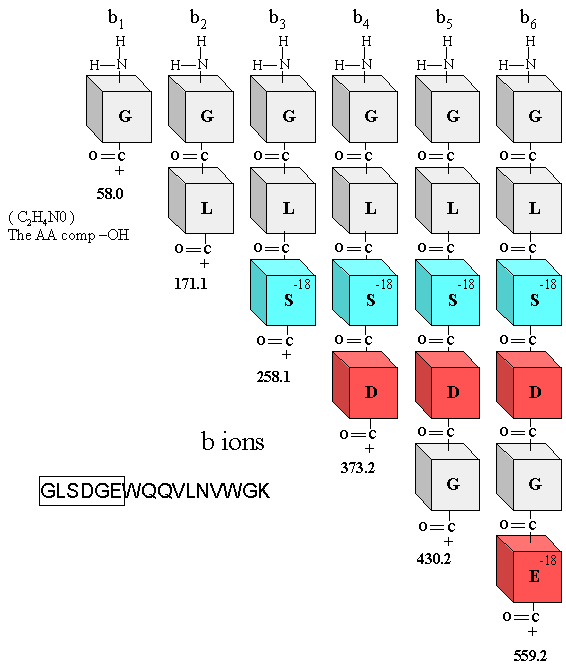 |
||
| Figure 3. Shows the first six b ions in a little bit more detail. The b ion m/z value is basically the mass of the peptide minus OH, or -17u. | ||
|
|
||
| Similarly, groups of peptide fragment ions appear to extend from the C-terminus, these peaks are termed, "y ions". The y ion series for our example peptide GLSDGEWQQVLNVWGK is illustrated below in Figure 4. | ||
|
|
||
| Figure 4.
|
||
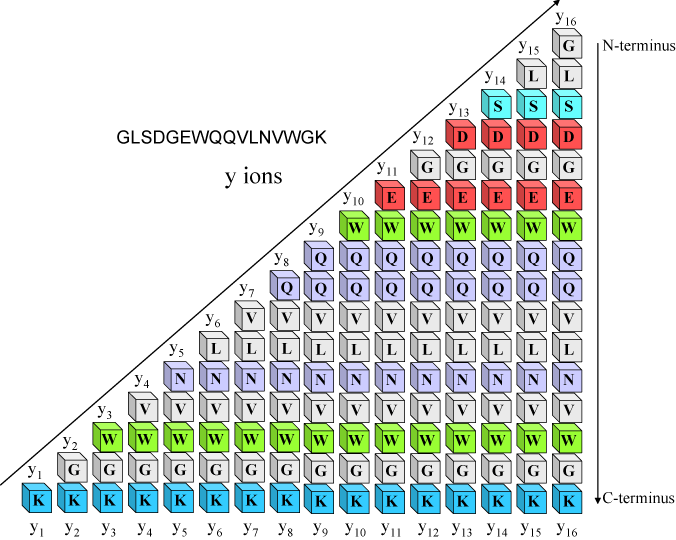 |
||
|
Below in Figure 5 the first six y ions are illustrated in some detail. To calculate the m/z value for the y ions just calculate the (M+H)1+ for the shortened peptide.
|
||
|
Figure 5
|
||
|
|
||
|
Figure 5. The first six y ions are illustrated. The calculated masses are shown above each y ion in bold numbers. |
||
| - | ||
|
y and b ion mnemonic: |
||
| To remember which are y ions and which are b ions you can remember that b ions are the series that extend from the amino terminus, or the front of the peptide. To us, it would make more sense if the b ions extended from the back or C-terminus, but just the opposite is true, b ions extend from the front of the peptide, the amino terminus. | ||
|
The screen shot below is the output of a free on-line calculator provided by the Institute of Systems Biology. All you need to do is paste in the sequence of your peptide and it will output the expected y and b ions. The URL for this resource is http://db.systemsbiology.net:8080/proteomicsToolkit/index.html You can use these masses to casually match up the masses to the peaks in Figure 1, at the top of the page. |
||
|
Figure 6. |
||
|
|
||
| De Novo sequencing seems petty simple right? Well, before we proceed onto our first example we should learn some of the rules and observations that scientists have previously made that will help us when we start looking at real data. | ||
|
|
||

|

|
|
| back | forward | |
|
|
||
| e-mail the webmaster@ionsource.com with all inquiries | ||
|
home
| terms of use
(disclaimer) Copyright � 2012 IonSource All rights reserved. Last updated: Monday, February 01, 2016 11:05:24 AM |
||
|
|
||

